The narcissus flower is one of the symbols of Rocca Priora to which the municipality of Castelli Romani dedicates a festival in May and which inspired the artist Mario Robazza in his creation of the Fountain of Narcissus right at the entrance to the historic centre.
But Narcissus in art had many other meanings and the flower takes its name from the myth of Narcissus, the beautiful son of the river god Censo and the nymph Lirope. Its name derives from the Greek "nàrke" which means numbness: a prophetic name.
His mother asked the fortune teller Tiresia about the fate reserved for her son and the prophecy was an enigma: Narcissus would live until he met himself.
Passionate about hunting, Narcissus tirelessly walked through the mountains and woods until he met the nymph Eco who fell madly in love with him. Narcissus refused Eco's love, and she left to never be found again.
Echo was consumed with love and became a shadow of which nothing remained but her voice.
But Nèmesi the terrible goddess of Vendetta who punished the errors and sweetness of men, disdained by the indifference of Narcissus took pity on poor Eco and wanted to avenge her. She led Narcissus to the bank of a spring whose clear and deep waters sent his image back to him like in a mirror.
Narciso fell in love with his reflected image and no longer found the strength to detach himself from it, so much so that he died of anguish when he realized he could not possess it. Narcissus died consumed by his vain and ridiculous love and was transformed by the avenging goddess into the flower that retains his name.
The myth of Narcissus appears in Ovid's Metamorphoses and was taken up in the Renaissance in the reinterpretation of the theme of Francis Bacon, as a warning against vanity.
This mythological figure then had considerable importance in German culture, in authors such as Herder and Hamann, who reinterpreted the figure of Narcissus in a romantic mode.
Self-love became the object of study for nascent medical science: psychoanalysis.
Now let's see some paintings that depict the myth of Narcissus.
Three artists, one subject: Narcissus according to Waterhouse, Caravaggio and Dalì
[caption id="attachment_117004" align="center-block" width="750"]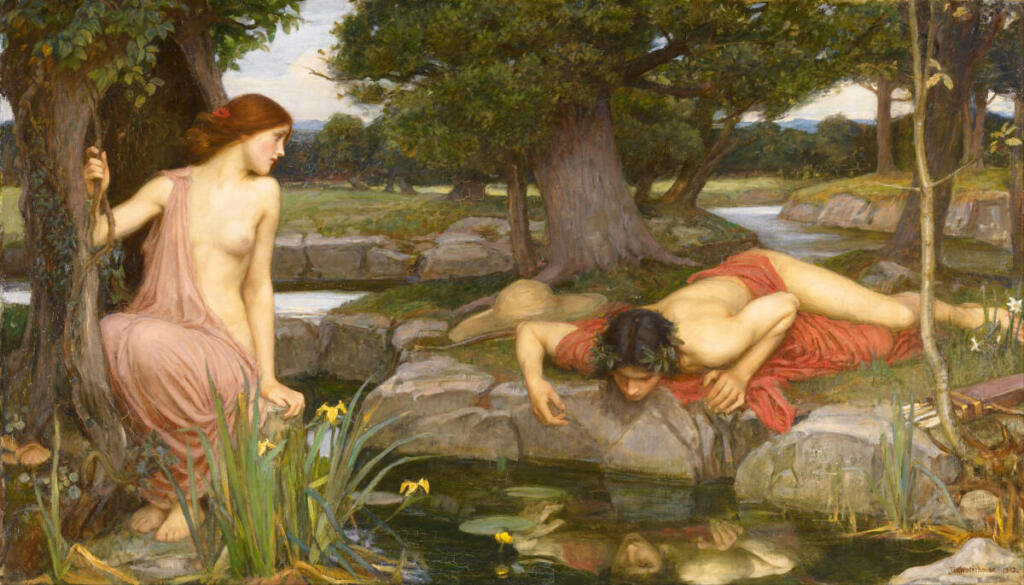 Narcissus (1903 - Walker Art Gallery) by John William Waterhouse - (c) Google Cultural Insitute[/caption]
Narcissus (1903 - Walker Art Gallery) by John William Waterhouse - (c) Google Cultural Insitute[/caption]
John William Waterhouse
The punishment of Nemesis affects the pride and arrogance hidden under the superficial beauty of Narcissus by making him run into a body of water where he sees his image for the first time.
A fairy-tale, Shakespearean, where the triangle of the looks of Eco-Narcissus-Water are perfectly described and the melancholy of the young nymph who does not see his gaze and his feeling of love for himself.
Caravaggio
[caption id="attachment_117001" align="pull-left" width="248"]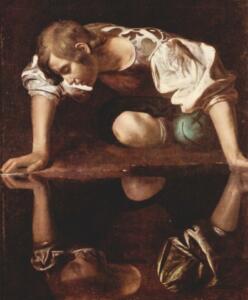 The Narcissus of Caravaggio (1598 - Palazzo Barberini) - (c) Galleria Nazionale d'Arte Antica - Palazzo Barberini[/caption]
The Narcissus of Caravaggio (1598 - Palazzo Barberini) - (c) Galleria Nazionale d'Arte Antica - Palazzo Barberini[/caption]
The Narcissus of Caravaggio (1598 - Palazzo Barberini)
A solitary portrait on a gloomy background where what emerges is only the image of Narcissus. He is completely absorbed in the contemplation and regardless of the spectator.
Its medieval, anachronistic clothes are reflected in all their details in the body of water.
Caravaggio captures the exact moment when Narcissus becomes aware of the impossibility of rejoining his image.
In his work there is all the loneliness and suffering of those who, in search of impossible perfection, push away the imperfection of human affection.
Salvador Dalì
[caption id="attachment_116998" align="center-block" width="730"]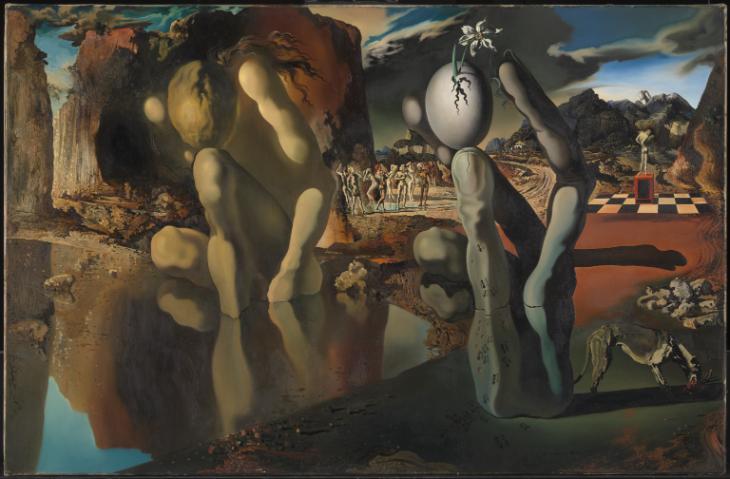 Salvador Dali The Metamorphosis of Narcissus (1936 - Tate Modern) - (c) Salvador Dali, Gala-Salvador Dali Foundation/DACS, London 2016 / Photo (c) Tate[/caption]
Salvador Dali The Metamorphosis of Narcissus (1936 - Tate Modern) - (c) Salvador Dali, Gala-Salvador Dali Foundation/DACS, London 2016 / Photo (c) Tate[/caption]
While Caravaggio represents solitude, Salvador Dalì stages the double, resulting from the mirror reflection.
The painter describes the transformation from the dying body into fossilisation to a new creature, whose transparent features gradually become more opaque and materialize twice as much.
It is a rebirth represented by the polysemic nature (different interpretations) of the image, where the individual's body takes the form of a hand clutching an egg from which a flower emerges: The narcissus.
On the eye, its fleshy nature, strong and delicate at the same time, painted in a flashy white or yellow colour are perfectly described, shedding light on Narcissus's personality.
The Fountain of the Narcissus by Mario Benedetto Robazza
[caption id="attachment_36274" align="center-block" width="750"]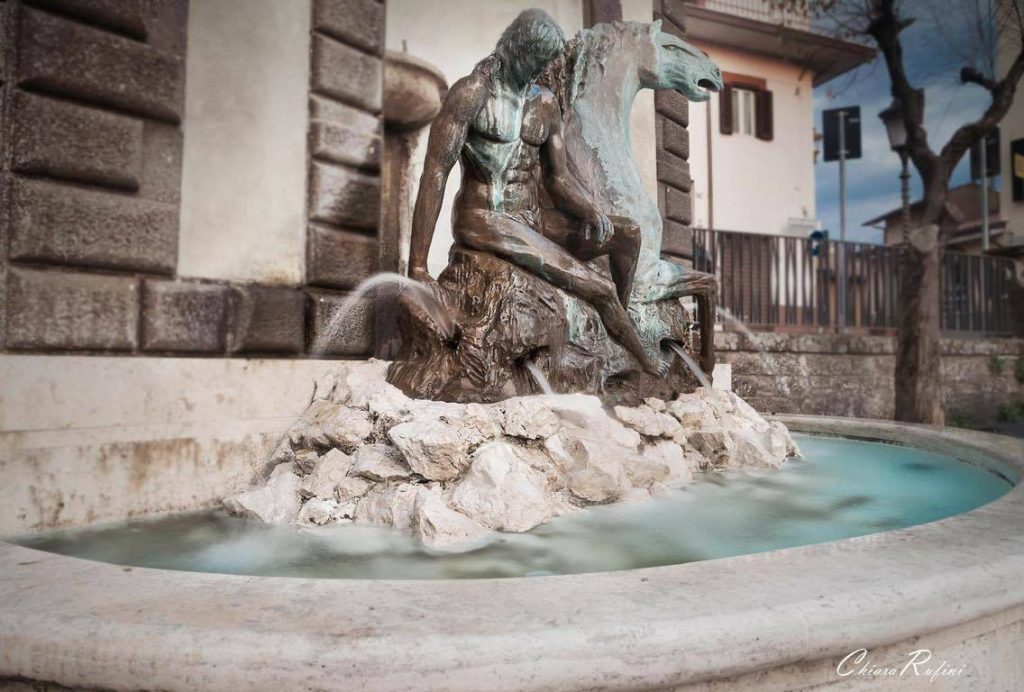 The Fountain of the Narcissus - Robazza by Chiara Rufini[/caption]
The Fountain of the Narcissus - Robazza by Chiara Rufini[/caption]
The Narcissus Fountain that is reflected in the water is located in the centre of the village of Rocca Priora and is a bronze work that Maestro Mario Benedetto Robazza has donated to the municipality.
The work forms the centre-piece of the Museo Diffuso Cittadino, a real artistic journey totally dedicated to the sculptor and located throughout the streets of the whole town.
It starts from the Buero Fountain, a sumptuous rampant horse in resinated marble placed at the entrance of the village on Via Tuscolana, and continues as in a sort of artistic "treasure hunt", with the bronze stations of the The Way of the Cross that climb all along the alleys of the historic centre up to the Church of Santa Maria Assunta in Cielo.
Following this itinerary, you will then come across the "The Triumph of Good" fountain located at the gates of the Ancient Medieval Village and which was originally part of a large bronze door from the artist's house-museum.
It ends on the highest peak of Rocca Priora, where the Benedetto Robazza Museum is located.
Returning to the Fountain of Narcissus, it is interesting to note that the artist has chosen to do a self-portrait of himself as the male subject of the Narcissus. And this is a detail that also occurs in many other works including the face of Count Ugolino in Dante's frieze L 'Inferno by Robazza.
The presence of the horse is foreign to the original myth, but the horse is an extremely dear subject to the maestro Robazza. Symbol of pride and strength, the horse is caught in a gesture of impetus, and seems to emerge from a rock on which the young Narcissus gently lays down.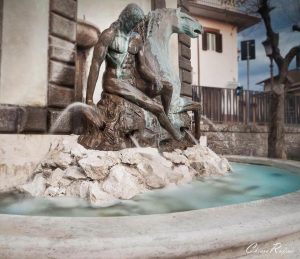
The myth is recalled by the presence of water from the fountain, a symbol of the pond in which the youth will fatally decide to mirror himself and lose his life.
The face, as well as the gaze of the child, appear in fact lowered into a melancholy state of mind, almost prophetic of its imminent end.
Mario Benedetto Robazza, The Fountain of the Narcissus who is reflected in the water







Follow us